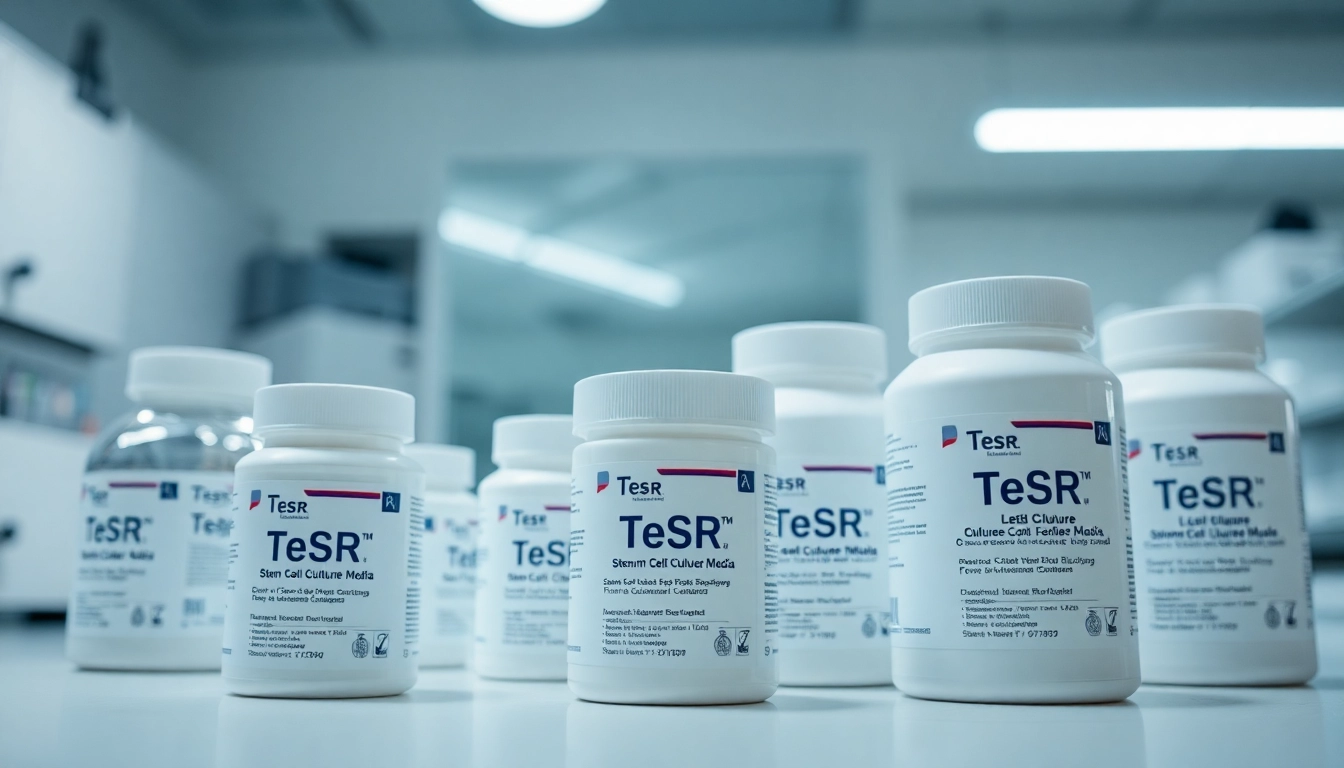Understanding TeSR™ Feeder-Free Media
Introduction to Pluripotent Stem Cells
Pluripotent stem cells (PSCs) are a unique class of stem cells capable of differentiating into any cell type in the human body, making them invaluable in regenerative medicine, drug testing, and disease modeling. Derived from human embryonic stem (ES) cells or induced pluripotent stem (iPS) cells, these cells hold immense potential due to their ability to proliferate indefinitely while maintaining the capacity for multilineage differentiation. With advancements in stem cell research, particularly in feeder-free culture technologies, maintaining the quality and integrity of these cells has never been easier. For comprehensive insights into the TeSR™ Media family that facilitates this process, refer to all check.
Benefits of Feeder-Free Culture Systems
The shift towards feeder-free culture systems for PSCs has revolutionized stem cell research. Traditional feeder-dependent methods often lead to variability due to differences in feeder cell preparation and growth factors. Feeder-free media, such as those in the TeSR™ family, provide a defined, consistent environment that reduces variability and enhances reproducibility in experiments. Key benefits of feeder-free systems include:
- Reduced Contamination Risks: Eliminating feeder layers substantially decreases the potential for bacterial, fungal, and mycoplasma contamination.
- Defined Culture Conditions: Feeder-free media, precisely formulated, offer standardized conditions that are crucial for the reproducibility of experimental results.
- High Pluripotency Maintenance: Feeder-free culture systems are designed to maintain high levels of pluripotency, ensuring that PSCs remain capable of differentiating into desired lineages.
Overview of TeSR™ Media Variants
The TeSR™ family encompasses a range of feeder-free media designed to enhance the growth, maintenance, and differentiation of hPSCs. Each variant serves distinct research needs:
- mTeSR™ Plus: A popular choice for routine maintenance of hPSCs, designed for extended culture without the need for frequent media changes.
- TeSR™-E8™: A simplified formulation containing only essential components, ideal for minimalistic approach researchers.
- TeSR™-AOF: An animal origin-free medium that reduces the risk of contamination from animal-derived materials, thus appealing to researchers focused on safety and ethics.
Key Formulations in TeSR™ Media
Highlights of mTeSR™ Plus
mTeSR™ Plus represents a significant advancement in hPSC maintenance. Unlike standard media, mTeSR™ Plus includes stabilized components and enhanced buffering, significantly minimizing the risk of acidification during extended culture periods. Researchers have reported substantial improvements in cell morphology and pluripotency retention when using mTeSR™ Plus, making it a preferred option in numerous laboratories worldwide.
Understanding TeSR™-E8™
TeSR™-E8™ is distinguished by its simplified formulation. It contains the minimal components necessary to maintain hPSCs without compromising their pluripotency. This media is particularly beneficial for researchers looking to streamline their protocols and reduce overall costs while ensuring cell health and functionality. With a strong emphasis on reproducibility, TeSR™-E8™ enables more consistent results in differentiation and other downstream applications.
Comparing TeSR™-AOF and mTeSR™1
TeSR™-AOF and mTeSR™1 are both pivotal in maintaining hPSC cultures, but they cater to slightly different research priorities. TeSR™-AOF is designed explicitly for those needing animal-free solutions, ensuring compliance with stringent regulatory standards. On the other hand, mTeSR™1, having been in use for years, provides splendid support for hPSC growth within a conventional framework. Both products deliver high performance in the correct contexts, allowing researchers to select based on their specific project needs.
Applications and Advantages of TeSR™ Media
Using TeSR™ for hPSC Maintenance
TeSR™ media have been crafted to support the consistent maintenance of hPSCs over extended periods. Their formulations ensure optimal cell growth, while providing a conducive environment that maintains the cellular characteristics required for downstream applications. The media support not only routine culturing but also facilitate the transition to differentiation protocols smoothly, ensuring that the cells retain functional pluripotency throughout.
Reprogramming with ReproTeSR™
ReproTeSR™ is tailored for the reprogramming of somatic cells into iPSCs. Its unique formulation provides a robust environment that enhances the efficiency of reprogramming. Researchers have utilized ReproTeSR™ successfully for various somatic cell types, achieving high conversion rates with optimal cell quality. This media reduces the time and resources typically needed for successful iPSC generation.
Differentiation Media: TeSR™-E5 and TeSR™-E6 Insights
TeSR™-E5 and TeSR™-E6 are specialized media for facilitating the differentiation of hPSCs toward specific lineages. TeSR™-E5 is particularly notable for its formulation that supports the development of definitive endoderm and mesoderm derivatives, while TeSR™-E6 targets ectoderm lineages. These media ensure that the cells not only differentiate effectively but also maintain high cellular integrity, thereby preserving functional capacities post-differentiation.
Guidelines for Optimal hPSC Culture
Best Practices for Media Change and Maintenance
Effective media management is crucial for maintaining the viability and functionality of hPSC cultures. Best practices for media changes include:
- Perform media changes every 2-3 days to ensure a fresh supply of nutrients.
- Carefully aspirate the old medium without disturbing the cell layer.
- Gently add fresh medium to avoid shear stress to the cells.
Routine monitoring of cell morphology and confluence will help in determining the optimal time for media changes.
Cytokine Function in TeSR™ Media
Cytokines play a vital role in mediating the effects of TeSR™ media on hPSC cultures. They influence cell proliferation, differentiation capabilities, and overall health. Understanding the specific functions of cytokines in the context of TeSR™ formulations can enhance researchers’ control over culture conditions, allowing improved outcomes in maintenance and differentiation workflows.
Assessing Culture Quality and Pluripotency
Assessing the quality of hPSC cultures involves regular checks for morphological integrity, marker expression, and the ability to differentiate into various lineages. Common assessments include:
- Flow cytometry for pluripotency markers such as OCT4 and NANOG.
- Cell morphology assessment under a microscope.
- Functional assays post-differentiation to evaluate cellular identity and function.
Regular quality assessments are fundamental to ensure successful downstream applications of hPSCs.
Future Directions and Innovations in Stem Cell Research
Trends in Pluripotent Stem Cell Applications
The application of hPSCs continues to expand across various fields including regenerative medicine, drug discovery, and toxicology testing. As researchers seek to harness the potential of PSCs, innovative techniques are adapted to enhance their differentiation specificity and therapeutic applications. The development of personalized medicine strategies utilizing patient-specific iPSCs represents a promising frontier in stem cell research.
Emerging Technologies in Stem Cell Media Development
Emerging technologies are streamlining the development of hPSC culture media. Innovations like microfluidics and advanced bioreactor systems allow more precise control of microenvironments, promoting improved growth and differentiation of stem cells. These technological advancements enable researchers to replicate in vivo-like conditions, enhancing the physiological relevance of in vitro models.
Integration of TeSR™ with Advanced Bioreactor Systems
The integration of TeSR™ media with advanced bioreactor systems is poised to revolutionize large-scale PSC culture. By optimizing growth conditions and nutrient delivery, bioreactors can enhance cell proliferation and functionality, paving the way for mass production of stem cell-derived products. As this technology evolves, it will play a significant role in translating stem cell research from the laboratory to the clinic.



